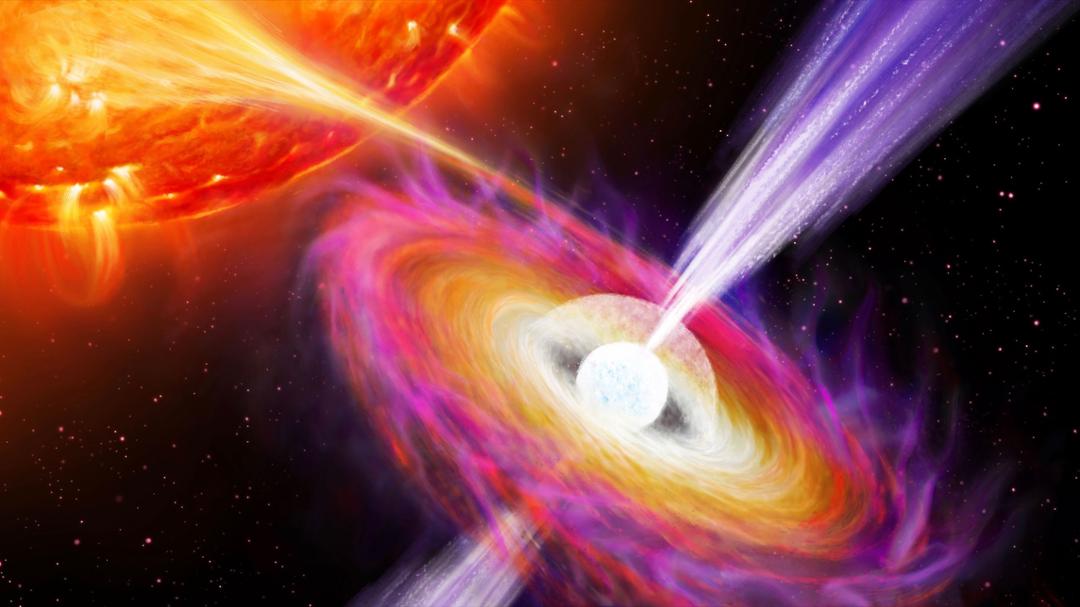Tom Maccarone in Physics and Astronomy is among authors whose groundbreaking work will soon be published in Nature magazine.
For Tom Maccarone, the universe really is his laboratory.
“I am drawn to the idea of things going on where there are conditions you have little or no hope of reproducing in a lab,” said Maccarone, a professor in the Department of Physics and Astronomy at Texas Tech University. “It gives you a way to do the most exotic physics experiments without having to build a giant laboratory. I am also drawn to problems where we still don’t really know anything.”
Maccarone recently enjoyed the best of both notions in researching the impacts of relativistic jets on neutron stars, relatively small yet extremely dense objects in the distant corners of space. For example, the neutron stars Maccarone’s research group examined are typically between 10,000 and 20,000 light years away.

The group’s work discovered something fundamentally new in the way neutron stars interact with these jets. The findings are so promising they will be published in a forthcoming issue of the prestigious magazine Nature. Maccarone is one of several authors of the paper as is Alex Tetarenko, who held an Einstein Fellowship from NASA at Texas Tech and is now at the University of Lethbridge in Alberta, Canada.
The other lead authors are Thomas Russell, an astrophysics researcher based in Palermo, Italy; Nathalie Degenaar with the University of Amsterdam; and Jakob van den Eijnden with the University of Oxford.
“Typically, a neutron star is an object about the size of a city,” Maccarone said. “So, one might barely fit inside the loop (289 in Lubbock). But it has a mass that is about one and a half times that of the sun. We believe neutron stars form at the end of the lives of massive stars.”
When stars in a certain mass range begin to die, their matter collapses until they are mostly comprised of neutrons. As opposed to emission from supermassive black holes in the centers of galaxies, which change slowly over long periods of time, the emission from neutron stars can change dramatically within minutes.
The jets, meanwhile, comprise radiating particles traveling near the speed of light. In a process known as accretion primarily driven by gravitational fields near the objects, particles rapidly accumulate in neutron stars and form disks.
“There has been a longstanding view about how these jets are powered when there are accretion disks around a neutron star,” Maccarone said. “You will get a strong emission from the jet when the magnetic field has a large height compared to how far out they are.”
Beyond that, though, the team found a thermonuclear burst also takes place on the surface of the neutron star. Through accretion, the matter on the surface is made up almost exclusively of hydrogen and helium atoms. As the temperature rises, nuclear fusion begins on the surface rather than within its core, which leads to the production of low-energy X-rays.
“It turned out the pressure on the surface of a neutron star is determined by a different process than just the temperature of the gas,” Maccarone said. “If you turn up the temperature, the nuclear reaction rate goes up and you get a runaway thermonuclear reaction.”
The discoveries align with work Maccarone originally began as a doctoral student more than 20 years ago. During work on his thesis, he observed connections between the temperature of the gas, the production of low- and high-energy X-rays and the corresponding height of magnetic fields.
He looked to confirm what he found. However, because in most cases, the high-energy X-rays are strong at the same time as the radio emission from jets, he proposed for time on the Very Large Array to test whether the jets turned off at the same time the high-energy X-ray emission does, but the proposals were considered too speculative, and he was unable to obtain telescope time.
Degenaar then found a Dutch grant program for high-risk, high-reward science, and the team was able to purchase telescope time on the Australia Telescope Compact Array to do the project.
“We were able to see that the radio emission actually shot up as a result of the jets’ burst,” Maccarone said. “What we think is happening is the gas was collapsing faster than the magnetic field. The other thing that happened when the gas cooled is the star is not orbiting as fast anymore and as it collapses in toward the neutron star, it drags the magnetic field with it.”
While the explanation of what is happening and why makes sense, Maccarone said their findings and projections still need to be confirmed by other theorists working in the same area.
“I think it is a two-stage thing,” he said. “Part of it we understand now, and part of it we want to see more theoretical work. What we’ve done is given some motivation to theorists to really explore this problem.”
Maccarone also will continue his work with these exciting, new findings getting his team telescope time with the Very Large Array and the Atacama Large Millimeter Array.
“The telescopes are more sensitive and will allow us to do things more precisely,” he said. “We have proof of concept and some exciting results, but the next thing we’d like to do since we’ve measured jet speeds with this technique is look at a number of neutron stars and see if the jet speeds vary systematically.
“If we see evidence of jet speeds correlating with the mass of neutron stars, we may have a way to find heavy neutron stars, which is important for understanding the physics of how these neutron stars work.”

